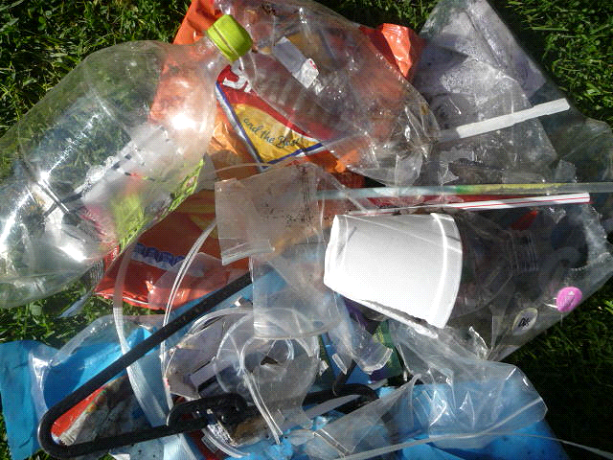Invopak’s new 100% oxy-biodegradable range from Cheko
Posted on November 9, 2012 by DrRossH in Plastic Waste NewsPackaging Europe – Invopak’s new 100% oxy-biodegradable range from Cheko.
This is an example of a company who has been mislead by sales people causing confusion of degradable and biodegradable issues as well as stretching the truth as to what these oxo additives really do. This note was sent to the company.
I just read in packaging news about your use of d2w into the Cheko plastic buckets. The article said
Cheko’s containers decompose into water, carbon dioxide, biomass and trace elements in just a few years, instead of clogging up landfill sites for years on end.
There are a number of things wrong with that statement.
1) With an oxodegradable plastic the plastic will fragment into lots of little pieces of plastic over time. The users have no control over how long this takes. It is a slow chemical reaction, nothing to do with decomposition by microrganisms. It will take a few years as you say. For a reusable container which it appears what the article was showing this may not be so desirable.
2) What happens to those lots of little plastic fragments is still heavily under debate in the industry as while the oxo additive manufacturers claim they will biodegrade after a very small size is attained by the degradation process, it is not possible to prove this with a recognised biodegradation test that measures CO2 emissions as proof of biodegradation. Some industry people say the plastic fragments just get smaller and smaller where they are not readily visible and hence claims of they are gone are made, when all that has happened is a plastic soup has been made. Mean while all these little fragments of plastic, if loose in the open are attractive for wildlife to try to eat or feed their young. There are numerous cases where bird deaths are shown due to ingesting of small plastic fragments.
3) You say instead of clogging landfill sites for years. This is not correct. If an oxodegradable plastic is discarded to a landfill and buried, it is deprived of oxygen and the chemical reaction stops. Then the plastic will stop degrading but sit just like a conventional plastic for a long long time. All the oxodegradable manufacturers agree with this. We see often where the salesman of the oxo additive are misleading clients all the time as to what these additives will do.
4) Even though you did not say it, an oxo additive cannot be recycled in mainstream recycling as the oxo plastic as could then cause the new items to degrade too and that may not be desired in the new product. This means oxodegradable plastics have to either go to landfill (where they will not degrade) or be incinerated (where degradation is not a factor). i.e. the oxo additive is doing nothing for either situation.
There are alternate additives available now that do not suffer from the above problems. These are called Landfill-biodegradable additives. It is essentially an organic additive that allows microorganisms to attack the plastic and digest it away. There is no degradation issue as nothing happens till the plastic is discarded to a landfill. The plastic item can sit or a shelf or be reused for many years with no change in the plastics properties. Only in a landfill where microorganisms are present will the plastic start to be biodegraded away. Since this is not a chemical reaction these plastics can be main stream recycled. The additives are added in just the same way you would add in an oxodegradable additive so no change in equipment is necessary. For some examples of manufacturers of these additives you can review websites like www.goecopure.com or www.ensoplastics.com for examples.

 How many people today grab a takeaway coffee cup from the local cafe to drink on the go? We don’t know, but the number must be enormous.. Most every one of the above have a plastic top that will last 100s of years. Some cafes still use plastic cups that last a similar time. Is 10 minutes of coffee worth 100s of years of trash?
These items can be seen littering our gutters and on our streets all over the place. If they were all cardboard, they would still be littered, but they would, at least, be gone in a short time.
They do not need to be made of plastic.
How many people today grab a takeaway coffee cup from the local cafe to drink on the go? We don’t know, but the number must be enormous.. Most every one of the above have a plastic top that will last 100s of years. Some cafes still use plastic cups that last a similar time. Is 10 minutes of coffee worth 100s of years of trash?
These items can be seen littering our gutters and on our streets all over the place. If they were all cardboard, they would still be littered, but they would, at least, be gone in a short time.
They do not need to be made of plastic.
 On the way home from the gym last week, a distance of about 1 km (1/2 mile), I counted the items of plastic litter on the curb as I walked. In that short distance I counted 63 pieces of plastic litter. Plastic drink bottles, bottle tops, candy wrappers, plastic film, polystyrene fragments etc. That seemed to be a lot to me. I guess it is a generational thing. Our parents would have been horrified to see that amount, whereas it seems to go unnoticed by our youth of today. In another 20 years how many pieces will there be on this stretch, -- 200? What will today’s youth think of that new amount then when they are older? Will their children be so readily accepting of a higher amount of litter?
On the way home from the gym last week, a distance of about 1 km (1/2 mile), I counted the items of plastic litter on the curb as I walked. In that short distance I counted 63 pieces of plastic litter. Plastic drink bottles, bottle tops, candy wrappers, plastic film, polystyrene fragments etc. That seemed to be a lot to me. I guess it is a generational thing. Our parents would have been horrified to see that amount, whereas it seems to go unnoticed by our youth of today. In another 20 years how many pieces will there be on this stretch, -- 200? What will today’s youth think of that new amount then when they are older? Will their children be so readily accepting of a higher amount of litter?
Discussion · No Comments
There are no responses to "Invopak’s new 100% oxy-biodegradable range from Cheko". Comments are closed for this post.Oops! Sorry, comments are closed at this time. Please try again later.